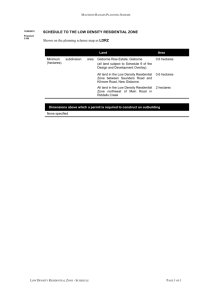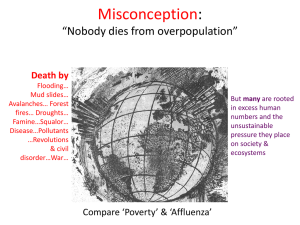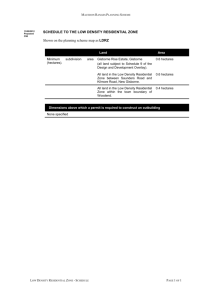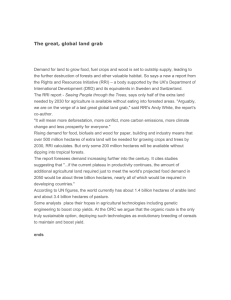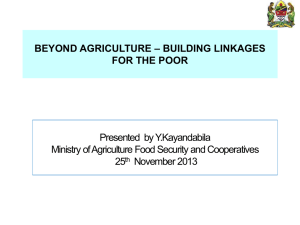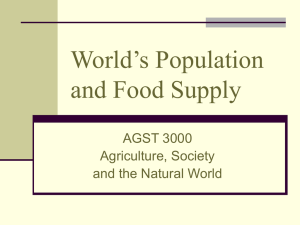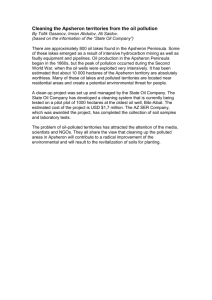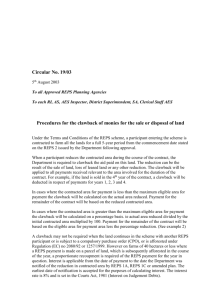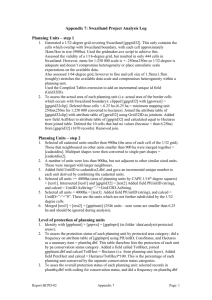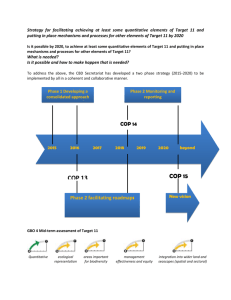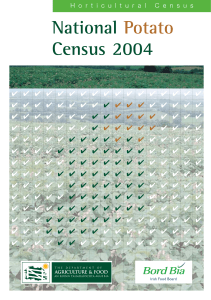FICCI Suggests Four-pronged Long-term Strategy to Make Economy
advertisement
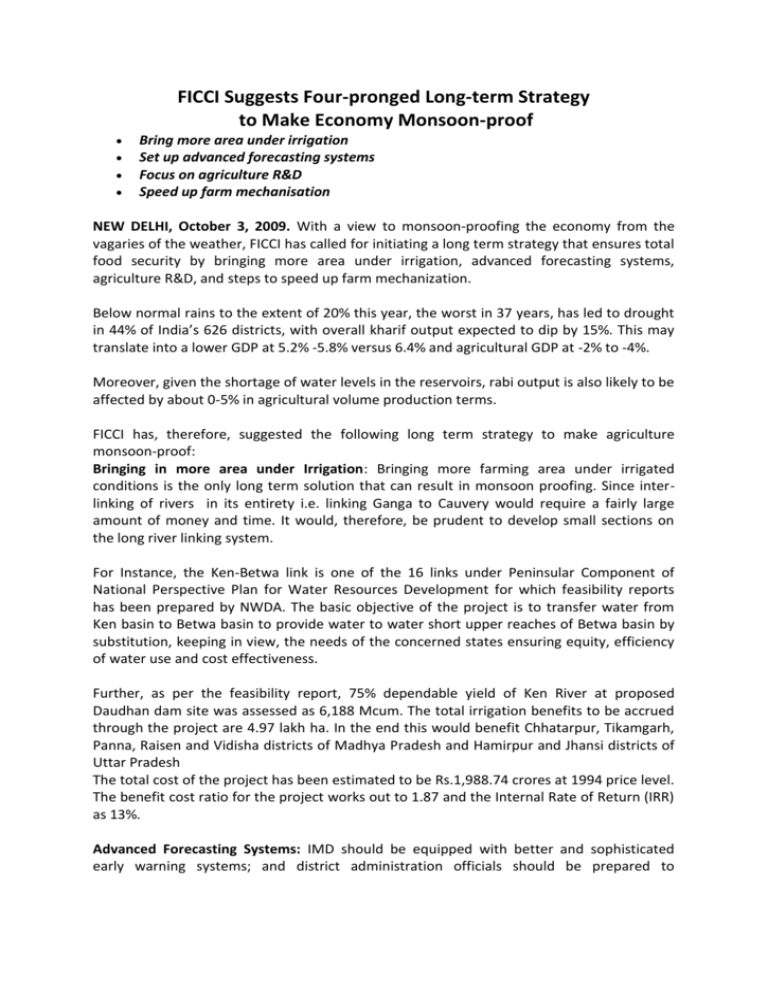
FICCI Suggests Four-pronged Long-term Strategy to Make Economy Monsoon-proof Bring more area under irrigation Set up advanced forecasting systems Focus on agriculture R&D Speed up farm mechanisation NEW DELHI, October 3, 2009. With a view to monsoon-proofing the economy from the vagaries of the weather, FICCI has called for initiating a long term strategy that ensures total food security by bringing more area under irrigation, advanced forecasting systems, agriculture R&D, and steps to speed up farm mechanization. Below normal rains to the extent of 20% this year, the worst in 37 years, has led to drought in 44% of India’s 626 districts, with overall kharif output expected to dip by 15%. This may translate into a lower GDP at 5.2% -5.8% versus 6.4% and agricultural GDP at -2% to -4%. Moreover, given the shortage of water levels in the reservoirs, rabi output is also likely to be affected by about 0-5% in agricultural volume production terms. FICCI has, therefore, suggested the following long term strategy to make agriculture monsoon-proof: Bringing in more area under Irrigation: Bringing more farming area under irrigated conditions is the only long term solution that can result in monsoon proofing. Since interlinking of rivers in its entirety i.e. linking Ganga to Cauvery would require a fairly large amount of money and time. It would, therefore, be prudent to develop small sections on the long river linking system. For Instance, the Ken-Betwa link is one of the 16 links under Peninsular Component of National Perspective Plan for Water Resources Development for which feasibility reports has been prepared by NWDA. The basic objective of the project is to transfer water from Ken basin to Betwa basin to provide water to water short upper reaches of Betwa basin by substitution, keeping in view, the needs of the concerned states ensuring equity, efficiency of water use and cost effectiveness. Further, as per the feasibility report, 75% dependable yield of Ken River at proposed Daudhan dam site was assessed as 6,188 Mcum. The total irrigation benefits to be accrued through the project are 4.97 lakh ha. In the end this would benefit Chhatarpur, Tikamgarh, Panna, Raisen and Vidisha districts of Madhya Pradesh and Hamirpur and Jhansi districts of Uttar Pradesh The total cost of the project has been estimated to be Rs.1,988.74 crores at 1994 price level. The benefit cost ratio for the project works out to 1.87 and the Internal Rate of Return (IRR) as 13%. Advanced Forecasting Systems: IMD should be equipped with better and sophisticated early warning systems; and district administration officials should be prepared to disseminate the information to farmers quickly and also propose remedial measures such as crop advisory that includes promotion of short duration and drought tolerance varieties. Agriculture R&D: Develop varieties that are resistance to heat, short duration and require minimal irrigation; the Government should actively engage the private sector in development of varieties that are drought tolerant; and the Government policy on GM crops should be made more conducive to attract large private investments in agri R&D. Farm Mechanization: To take advantage of the intermittent and unexpected rains during the monsoon season, farm mechanization has to be promoted in the country; Machines such as zero tillage, direct seeding of paddy and other equipments suitable to rainfed farming conditions have to be promoted among the farming community; custom hiring of farm machines have to developed as an organized sector and penetration of farm equipments has to be increased The Impact on kharif output is likely to be as follows: Loss of about six million hectares in paddy sowing in the rain-fed States Kharif or summer crop would decline by 15-20 per cent Loss in food-grains output owing to the drought has been estimated to be higher than 16 Mn Tonnes. In Punjab and Haryana, 20 to 30 per cent area has been shifted to late-sown basmati rice which cannot be procured for the Public Distribution System. This will affect the rice available for the central pool. Slight increase in cotton and pulses acreage The kharif crop scenario as on September 17, 2009 (includes other factors that are influencing production) is: RICE: Estimated at 30.87 million hectares till September 10, is 6.2 million hectares short of last year’s corresponding position. But, it is 6.1 million hectares more than the 24.73 million hectares planted till August 13 when the revival of the monsoon began. Government proposes to launch an extensive drive to promote cultivation of paddy in the ‘Boro’ season (pre-rabi) in eastern states and in the main rabi season to make up for the likely loss in kharif rice output. However, India’s rice output is expected to fall sharply to 82 million tonnes in the 2009-10 against the early forecast of 88 MT, according to USDA. This is 17 million tonnes below the 2008-09 record production of 99.2 million tonnes GROUNDNUT: Groundnut which has been planted on about 4.3 million hectares, down about 0.8 million hectares from last year’s 51.2 million hectares. The shortfall is said to be due to poor rain in the groundnut growing belts of Andhra Pradesh and Gujarat. The Indian Council of Agricultural Research (ICAR) is advising the farmers to plant toria (oilseed), which can be sown till September-end, to partly compensate for loss in the groundnut output. SOYBEAN: More or less the same as last year’s 9.5 million hectares and the crop condition is reportedly good in most areas except in parts of Maharashtra, where moderate to high incidence of pests and diseases has been observed. The overall output of soybean may be normal and will suffice to meet the demand of the soy-based industry. PULSES: Crops have been grown on about half a million additional area and the reports of sowing are still coming in. However, the additional production of pulses may not be able to reduce the import requirement, as, despite some drop in consumption on account of abnormally high prices, the demand supply gap may still top 1.5 million tonnes. COARSE CEREALS: marginally higher and, thanks to late rains, the output may exceed last year’s level. But the prices may remain firm due to persistent demand from the poultry and starch industries. COTTON: Grown on about 9.62 million hectares, up 1.13 million hectares from last season’s 8.48 million hectares. The sowing season is over. Excess rain may impair the condition of standing crop in some pockets. Impact on Rabi Output The government on September 18 accepted that the country is likely to produce 79 million tonnes (mt) of wheat in 2009-10, lower than last year’s record production of 80.58 mt and would mark the first year-on-year decline in output for four years. Wheat constitutes 72% of India’s total foodgrain output. Reservoir Levels While the facts on 81 of India’s biggest reservoir as on week ending September 17, 2009 show that the storage capacity as a percentage of the live capacity at 57% is much less than the average of the last ten year average i.e. 64% ( last year it was 69%). However, on a disaggregated level reservoirs in the northern region show enormous drops in levels which indicates significant strain on irrigation as well as hydel power projects. Note: A detailed paper on Strategy to make Agriculture Monsoon Proof is attached. MEDIA DIVISION
